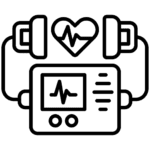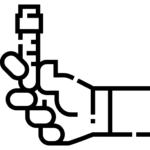In healthcare settings, time, accuracy, and swift response are critical. Patient monitoring systems have emerged as vital tools for healthcare professionals to optimize patient care. These monitors provide real-time data, enabling medical staff to make informed decisions quickly. Here’s how patient monitors contribute to streamlining patient care.
1. Continuous Monitoring of Vital Signs
Patient monitors are designed to track and measure a range of vital signs. These include:
- Heart rate
- Blood pressure
- Oxygen saturation (SpO2)
- Respiratory rate
- Temperature
By constantly monitoring these key parameters, healthcare professionals gain immediate insights into a patient’s condition. For instance, fluctuations in heart rate or blood pressure can indicate a potential problem, prompting timely intervention. Without continuous monitoring, these changes might go unnoticed until it’s too late.
Example:
In intensive care units (ICUs), a patient monitor can alert healthcare workers if a patient’s blood pressure suddenly drops. This can lead to quicker administration of medications or adjustments in treatment, preventing further complications.
2. Early Detection of Potential Problems
One of the primary benefits of patient monitors is their ability to detect issues early. These devices are programmed to trigger alerts when a patient’s vitals deviate from established thresholds. For instance, if a patient’s oxygen levels drop below a certain level, the monitor will signal an alarm, allowing the nurse or doctor to address the issue before it escalates.
Example:
A post-operative patient may experience sudden drops in oxygen saturation. A patient monitor would immediately notify the healthcare team, allowing them to administer oxygen or other necessary treatments without delay.
3. Improved Patient Safety
Patient monitors reduce the risk of medical errors, especially in high-stress environments like emergency rooms (ERs) and operating theaters. In these settings, multiple patients are often being treated at the same time. Having continuous, real-time data helps prevent errors that can occur when a healthcare professional is distracted or handling multiple tasks at once.
These systems also ensure that the correct medication is administered by tracking the patient’s response in real-time. If a patient has an adverse reaction to a drug, the monitor can alert the medical staff immediately.
Example:
In a busy ER, a patient monitor will display all relevant vitals, making it easier for medical staff to prioritize care based on severity. It reduces the chances of overlooking vital information in the chaos of the moment.
4. Increased Efficiency and Workflow Optimization
Patient monitoring systems help optimize the workflow by automating the collection of patient data. This reduces the amount of time healthcare professionals spend manually recording and interpreting vitals, allowing them to focus on patient care instead. The monitors feed data directly into electronic health records (EHR) systems, providing an up-to-date and comprehensive patient profile.
Healthcare workers no longer need to visit the patient as frequently for routine checks. Instead, they can focus their efforts on patients who show signs of deterioration, which leads to more efficient use of resources.
Example:
In a hospital ward, nurses can remotely monitor several patients at once from a central station. This allows them to identify which patients need immediate attention, without having to physically check each one at regular intervals.
5. Enhanced Communication Among Healthcare Teams
Patient monitors also improve communication within healthcare teams. They provide a centralized location for data, which can be accessed by any member of the care team. This leads to better collaboration, as everyone from doctors to nurses to specialists can review the same set of patient data.
In multi-disciplinary teams, where specialists from different fields are involved in a patient’s care, sharing real-time data is essential. The ability to access up-to-date information from a single source streamlines decision-making, ensuring that everyone is on the same page.
Example:
In a multidisciplinary care setting, patient data from the monitor can be shared instantly between a cardiologist, pulmonologist, and general physician, making it easier to coordinate treatment plans.
6. Customization and Tailored Treatment Plans
Different patients require different care strategies. Patient monitors allow healthcare professionals to customize monitoring parameters based on the patient’s medical history and specific needs. For instance, a patient with a history of heart disease may require more frequent monitoring of blood pressure and heart rate, while someone with respiratory issues may need continuous oxygen saturation tracking.
By setting personalized thresholds, patient monitors can help healthcare professionals make more informed decisions and provide customized care.
Example:
A patient who underwent heart surgery may have a specific threshold for heart rate or blood pressure. The monitor can be customized to alert staff if these values cross a predetermined range, enabling early intervention.
7. Remote Monitoring Capabilities
In recent years, advancements in telemedicine and remote monitoring have expanded the role of patient monitors. In outpatient settings, patients can now use home monitoring devices that send their vitals directly to their healthcare providers. This is particularly useful for patients with chronic conditions like diabetes, hypertension, or COPD, who need continuous monitoring but do not require hospitalization.
Remote monitoring allows healthcare professionals to track patient health without requiring them to be physically present. It also gives patients more control over their health by enabling them to stay connected with their care team from home.
Example:
A diabetic patient can use a remote patient monitor to track their blood sugar levels and send the data to their doctor. If their levels go out of range, the doctor can make adjustments to the treatment plan without the patient needing to visit the clinic.
8. Better Decision-Making and Reduced Response Times
The data provided by patient monitors can inform better decision-making. With real-time insights into a patient’s condition, healthcare professionals can make adjustments to treatments or interventions quickly. This is especially crucial in emergency situations, where the speed of response can mean the difference between life and death.
Example:
During cardiac arrest, a monitor that tracks heart rhythms can provide immediate feedback to doctors, helping them decide whether to administer medication or perform CPR based on the patient’s current state.
9. Minimization of Manual Errors
Patient monitoring systems reduce the chance of manual errors, such as incorrect vital sign measurements. These systems can automatically record and process the data, eliminating the need for manual entry and reducing human error.
Example:
A nurse might accidentally record the wrong blood pressure value when taking manual readings. A patient monitor will automatically track and document the reading, minimizing the risk of errors in the patient’s medical record.
10. Support for Data-Driven Decision-Making
Patient monitors generate a wealth of data, which can be analyzed to identify trends, track patient progress, and predict outcomes. By reviewing this data, healthcare providers can make more accurate long-term decisions about patient care. These insights can also help predict complications, allowing for preventive measures to be put in place.
Example:
If a monitor shows that a patient’s oxygen saturation levels are gradually declining, healthcare professionals can initiate measures like adjusting ventilation settings or administering supplemental oxygen to prevent further deterioration.
FAQs About Patient Monitors
1. What is a patient monitor?
A patient monitor is a medical device used to continuously observe a patient’s vital signs, including heart rate, blood pressure, respiratory rate, temperature, and oxygen saturation. These devices are commonly used in hospitals, clinics, and other healthcare settings to ensure that patients are being monitored in real-time.
2. How do patient monitors improve patient care?
Patient monitors help improve patient care by providing real-time data on a patient’s health. This continuous monitoring allows healthcare professionals to detect problems early, respond quickly to changes in the patient’s condition, and make informed decisions that can prevent complications or medical errors.
3. What types of patient monitoring systems are available?
There are several types of patient monitoring systems, including:
- Cardiac monitors for heart rate and rhythm
- Pulse oximeters for oxygen levels
- Blood pressure monitors
- Multi-parameter monitors that track a range of vitals
- Wearable devices for remote monitoring of patients at home or outside the hospital setting
4. Can patient monitors be used at home?
Yes, some patient monitoring devices are designed for home use. These devices allow patients with chronic conditions to monitor their vitals and send the data to their healthcare providers for review. This form of remote monitoring helps doctors track patients’ conditions and adjust treatments as needed.
5. How do patient monitors help in emergency situations?
In emergencies, patient monitors provide immediate and critical data that can guide rapid decision-making. They allow healthcare professionals to assess a patient’s condition at a glance and take necessary actions without delay, potentially saving lives during critical moments.
6. Are patient monitors customizable for individual patients?
Yes, patient monitors can be customized to suit individual patients. Based on the patient’s medical history, healthcare providers can set personalized thresholds for vital signs, ensuring that alerts are triggered when specific conditions are met. This helps ensure tailored and precise care.
7. What role do patient monitors play in preventing medical errors?
Patient monitors play a significant role in preventing medical errors by automating the collection and documentation of vital signs. This reduces the chances of human error that can occur with manual measurements and ensures accurate, real-time data is always available.
Conclusion
Incorporating patient monitoring systems into healthcare practices is not just about collecting data—it’s about improving patient care and safety. These systems provide continuous, real-time insights into a patient’s health, helping healthcare professionals make quick, informed decisions. They enable early detection of issues, enhance communication within healthcare teams, and streamline workflows, ultimately allowing for more efficient care delivery.
As technology advances, the role of patient monitors will continue to expand, supporting better decision-making and improving outcomes for patients across all healthcare settings. By integrating these devices into daily practices, healthcare professionals can ensure that they are providing the best possible care to their patients.
 Hospital Furniture
Hospital Furniture Medical Devices
Medical Devices MSR Products
MSR Products Office Furniture
Office Furniture